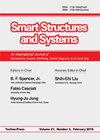逐步变参数斜辊式隔振器的控制性能
IF 2.2
3区 工程技术
Q2 ENGINEERING, CIVIL
引用次数: 2
摘要
在水平加速度控制性能相同的情况下,对被动提供逐步变参数和固定参数的倾斜滚动式隔震器的水平位移控制性能进行了数值研究。第一种设计在较小的水平隔震位移下具有较小的斜角和较大的阻尼力,在较大的水平隔震位移下具有较大的斜角和较小的阻尼力。也就是说,随着水平隔震位移的增大,该设计的倾斜角度逐步增大,阻尼力逐步减小。第二种设计与第一种设计理念相反,即随着水平隔震位移的增大,坡角逐步减小,阻尼力逐步增大。一系列数值计算结果表明,在坡角和阻尼力不变的情况下,一般情况下,阻尼力越大(即坡角越小),其水平最大位移响应越小,剩余位移响应越大。由于在不同阶段设计了更大的能量耗散能力,第一种和第二种逐步变参数设计在抑制远场和脉冲式近断层地震动下的水平隔离位移方面各有优势。当地震动末端水平隔震位移响应仍在第一坡滚动范围内,且第二种设计的倾斜角度较大时,采用第二种设计可以比采用第一种设计表现出更好的再定心性能。为了在不影响不同地震要求下的位移控制性能和加速度控制性能,与采用不变参数设计和第一种设计相比,采用第二种设计可能是一种替代方案和更好的选择。本文章由计算机程序翻译,如有差异,请以英文原文为准。
Control performance of sloped rolling-type isolators designed with stepwise variable parameters
With the same horizontal acceleration control performance, the horizontal displacement control performances of sloped rolling-type seismic isolators passively provided with stepwise variable parameters, as well as constant ones, are numerically investigated in this study. The first design possesses a smaller sloping angle with larger damping force at smaller horizontal isolation displacement and a larger sloping angle with smaller damping force at larger horizontal isolation displacement. In other words, this design has stepwise increased sloping angles and stepwise decreased damping force with increasing horizontal isolation displacement. The second design has an opposite design philosophy to the first one, i.e., it has stepwise decreased sloping angles and stepwise increased damping force with increasing horizontal isolation displacement. A series of numerical results present that for sloped rolling-type seismic isolators designed with a constant sloping angle and damping force, in general, the larger the damping force (in other words, the smaller the sloping angle), the smaller and the larger the horizontal maximum and residual displacement responses presented, respectively. The first and second designs with stepwise variable parameters each have its advantage for suppressing horizontal isolation displacement under far-field and pulse-like near-fault ground motions because of their larger energy dissipation capabilities designed at different stages. When the horizontal isolation displacement responses at the end of ground motions are still within the first slope rolling range with a larger sloping angle of the second design, as expected, adopting the second design can exhibit a better re-centering performance than adopting the first design. To have acceptable displacement control performances and without scarifying acceleration control performances under diverse seismic demands, compared with adopting the designs with constant parameters and the first design, adopting the second design could be an alternative solution and better choice.
求助全文
通过发布文献求助,成功后即可免费获取论文全文。
去求助
来源期刊

Smart Structures and Systems
工程技术-工程:机械
CiteScore
6.50
自引率
8.60%
发文量
0
审稿时长
9 months
期刊介绍:
An International Journal of Mechatronics, Sensors, Monitoring, Control, Diagnosis, and Management airns at providing a major publication channel for researchers in the general area of smart structures and systems. Typical subjects considered by the journal include:
Sensors/Actuators(Materials/devices/ informatics/networking)
Structural Health Monitoring and Control
Diagnosis/Prognosis
Life Cycle Engineering(planning/design/ maintenance/renewal)
and related areas.
 求助内容:
求助内容: 应助结果提醒方式:
应助结果提醒方式:


